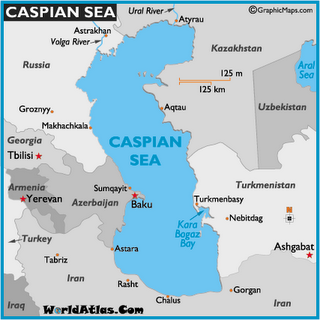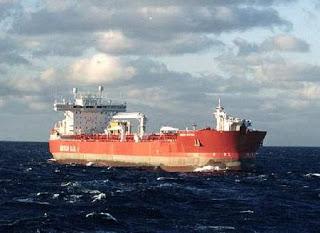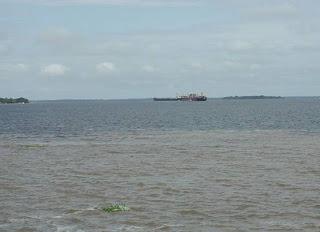 About five hours after the launch of Apollo 17, in the early morning hours of December 7, 1972, the astronauts of man’s final lunar mission turned their gazes back to Earth. Their capsule was positioned between the Earth and the sun, and from their God’s-eye view 28,000 miles overhead they saw a full hemisphere bathed in light and shining spectacular blue against the black void of space. The photograph they took of the scene is one of the most iconic views of our planet and has become famously know as the “blue marble”.1Take a look at a globe or a world map and you see mostly blue, and as we all learned as school kids, about 70 percent of the Earth’s surface is covered by water. There’s even a term for all this water, the hydrosphere. Virtually all of the hydrosphere is part a vast connected world ocean; the oceans, seas, bays, gulfs, bights, channels, estuaries, firths, fjords, sounds, and straits, which despite the many names we give them, comprise a single body of water.2There is, however, one conspicuously massive body of water that isn’t part of this world ocean, the landlocked Caspian Sea.
About five hours after the launch of Apollo 17, in the early morning hours of December 7, 1972, the astronauts of man’s final lunar mission turned their gazes back to Earth. Their capsule was positioned between the Earth and the sun, and from their God’s-eye view 28,000 miles overhead they saw a full hemisphere bathed in light and shining spectacular blue against the black void of space. The photograph they took of the scene is one of the most iconic views of our planet and has become famously know as the “blue marble”.1Take a look at a globe or a world map and you see mostly blue, and as we all learned as school kids, about 70 percent of the Earth’s surface is covered by water. There’s even a term for all this water, the hydrosphere. Virtually all of the hydrosphere is part a vast connected world ocean; the oceans, seas, bays, gulfs, bights, channels, estuaries, firths, fjords, sounds, and straits, which despite the many names we give them, comprise a single body of water.2There is, however, one conspicuously massive body of water that isn’t part of this world ocean, the landlocked Caspian Sea. For all you amateur geographers out there, the Caspian Sea presents a riddle of geography and definition. Is it a real sea, or is it just a big lake? What does the word “sea” actually mean, and speaking geographically, what is a sea really? I ask these questions because we humans love to classify, to put a blanket of order on the world. But let’s come back to this.
Is the Caspian a Sea or a Lake?
 The Caspian Sea lies a few hundred miles east of the Black Sea along borders of Europe, central Asia, and the Middle East. Territorially it’s divided between Russia in the northwest, Azerbaijan to the west, Iran in the south, Turkmenistan in the southeast, and Kazakhstan in the northeast. It’s famous as the fishing grounds for much of the world’s sturgeon, the major source of caviar. Lately its oil-rich shores and seabed have become the crucial economic engine of the region (and a source of political tension among the surrounding countries). And it is a one-of-a-kind body of water.
The Caspian Sea lies a few hundred miles east of the Black Sea along borders of Europe, central Asia, and the Middle East. Territorially it’s divided between Russia in the northwest, Azerbaijan to the west, Iran in the south, Turkmenistan in the southeast, and Kazakhstan in the northeast. It’s famous as the fishing grounds for much of the world’s sturgeon, the major source of caviar. Lately its oil-rich shores and seabed have become the crucial economic engine of the region (and a source of political tension among the surrounding countries). And it is a one-of-a-kind body of water. You look in most atlases or encyclopedias and the Caspian Sea is listed as the world’s largest lake. Its maximum length (north to south) is 640 miles and its max width (east to west) is 270 miles. It covers an area of 143,000 square miles (371,000 square km),3which makes it about the same size as Montana or all the islands of Japan, and bigger than Germany; it could easily accommodate all of the British Isles. It’s also really deep. The southern third of the Caspian is oceanic with a maximum depth greater than 3,300 feet. The total volume of water is about 18,800 cubic miles (78,000 cubic km).4 These dimensions dwarf all other lakes. By area the next biggest lake is Lake Superior (the greatest of the Great Lakes), which itself is huge with an area of a little under 32,000 square miles. But this is four and a half times smaller than the Caspian. In fact, the Caspian in larger in area than the next seven largest lakes combined.5 Just to emphasize the point, the Caspian is 50 percent larger than the combined area all of the North American Great Lakes. A comparison of volume tells the same story. The Caspian holds more than three times the water of the mile-deep Lake Baikal (the world’s most voluminous fresh water lake) and more than the next seven lakes combined.6
---
Before we go further, a quick aside for definitions:
- Sea: (1) the salt waters that cover the greater part of the Earth’s surface; (2) a division of these waters, of considerable extent, more or less definitely marked off by land boundaries; (3) a large lake or landlocked body of water.
- Lake: a body of fresh or salt water of considerable size, surrounded by land.
These are dictionary definitions but they jive pretty well with wordier geographic definitions. And they don’t help us answer the question of whether the Caspian is a sea or a lake.
---
The Caspian is so large that its shores touch on radically different climates. There’s the cold deserts of Kazakhstan the Turkmenistan, the arid Russian steppes, the high mountains of the Caucasus, the dry subtropical plains of Azerbaijan, and the lush, verdant subtropical forests of northern Iran. Baku, the capital of Azerbaijan is the largest city situated on the Caspian, but Iran’s capital Tehran and Russian Astrakhan7aren’t too far removed from its shores.

Oil tanker on the Caspian Sea
The Caspian is an endorheic basin. That means it doesn’t have any outflows. Water comes in via rivers and streams but can only leave through seepage or evaporation. And like most other endorheic bodies of water (e.g., the Great Salt Lake and the Dead Sea) it is salty. The saline concentration varies greatly, but on average it’s about as third as salty as typical ocean water. The Caspian is fed by the longest river in Europe, the Volga, which supplies 80 percent of the inflow. This is unusual because all of the world’s great rivers – except the Volga – flow into the world ocean. Many large rivers have their source in lakes, like the Nile at Lake Victoria and the Congo at Lake Tanganyika, but no others empty into one. The Caspian’s level is independent of the world ocean, and it’s the center of a large basin that sits below global sea level (presently the surface sits about 92 feet below sea level). In fact the geology of the southern part of the Caspian is oceanic as the seabed is oceanic crust and not continental crust.Caspian Sea and Lake
So given all these facts, I’m going to argue that the Caspian is both a lake and a sea, a mini ocean. It’s a lake for the simple reason that it is landlocked; it’s distinct from the world ocean. It’s a sea because it’s huge relative to other lakes, salty like the sea (just not as salty), deep like an ocean, geologically oceanic (at least in part), ancient (it’s been there for 5.5 million years), and the outflow for one of the world’s largest rivers. If you compare the Caspian to many mediterranean seas (a sea mostly enclosed by land within distinct circulation patterns, hence the lower case “m”), it is about the same size (a little smaller) than the Black Sea and Red Sea, the same size and saltier than the Baltic Sea8, and much bigger than the Persian Gulf.
All of this is to say that the Caspian is two things at once, a sea and a lake, a sea-lake; it defies easy classification. And the more you look at our world’s geography, the more of these classification conundrums you find.
Geographical Conundrums
Here’s another geographic riddle that a lot of us pondered when we were taught about the continents in school: Is Australia an island? You look at the map and it’s pretty obvious that Australia is surrounded on all sides by water. But the answer from geographers is that Australia is too big to be an island, instead it’s a continent. By far the smallest continent, the mainland of Australia is a little more than half as big as the next smallest continent, Antarctica (assuming we lump Europe in with Asia – Eurasia, as geographers usually do), but a continent nonetheless. After all, the world ocean surrounds all continents so they all are islands if we go strictly by the land-surrounded-by-water definition. So we make a call, Australia is big enough to be a continent and too big to be an island. Still, the division between island and continent is arbitrary (just like the division between sea and lake).
The world’s biggest island is frozen Greenland, which at 823,000 square miles is larger than all but eleven countries. It’s also almost three times larger than the second largest island, New Guinea, and larger than the next three largest islands combined (New Guinea, Borneo, and Madagascar). And here we are back with another Caspian-like argument. Could Greenland be considered a continent? And the trouble with classification is again revealed, Earth’s geography doesn’t fit into easy discrete divisions; Australia the island continent, Greenland the continental island.

The wide Amazon River near its mouth
The examples continue. The Amazon River, the drain of the huge Amazon basin and the Amazon rainforest, discharges 209,000 cubic meters of water per second into the Atlantic Ocean. Its largest tributaries, the Madeira Riverand Rio Negro are, by discharge, the sixth and seventh largest rivers in the world, respectively. The Amazon discharges more water than the next nine largest rivers combined (not counting its own tributaries). It discharges five times as much water as the Congo (second highest discharge), and 13 times as much as the mighty Mississippi. All told it accounts for one-fifth of the world’s total river flow. The Amazon is as wide as six miles during the dry season and floods to more than 30 miles wide during the rainy season. It reaches depths of 300 feet (it averages about 150 feet deep for most of its lower stretches). The island of Marajo at the river’s mouth is over 15,000 square miles, lager than Switzerland. We don’t have a term for a river that’s bigger than a river. A super-river perhaps, or better yet, what the locals call it: the river-sea. Whatever the Amazon is, it makes all the world’s other great rivers seem insignificant.If we bring this back to seas and oceans, is the Pacific Ocean so large that it could be considered something else? It could easily accommodate all the world’s landmasses. It includes the deepest point on the planet’s crust (the Challenger Deep of the Mariana Trench) and the point farthest from any land (Point Nemo). It is by far the dominant geographic feature of Earth. It covers one-third of the Earth’s surface. But again we lack the proper vocabulary; maybe we could call it a planetary ocean?
There are no real answers to these questions, or better stated, it doesn’t matter whether the Caspian is a sea or a lake, or both; whether a landmass is a continent or an island; whether a river or ocean is so big that it’s something else. Our Earth is an endlessly fascinating place, and often too complex and nuanced for simple human ordering.
---
NOTES:
1. Fun fact: Despite our perception of land as being generally uneven and covered over great areas by rolling hills, and extensive canyons and basins, and massive mountain ranges with their high craggily peaks, and if you poured away the oceans, deep trenches, if we could actually hold the Earth between our fingers it would feel far smoother than and most perfect blue marble you’ve ever held. (Although because if the equatorial bulged caused by the planet’s rotation, Earth is less round than that same (well machined) marble.)
2. This is true in as much that these waters are all connected and mix, but hydrologically they vary greatly from place to place. For instance, consider the waters in Taganrog Bay one the one hand and of the eastern Atlantic just west of the strait of Gibraltar on the other. These waters are connected via the Sea of Azov, Kerch Strait, the Black Sea, the Bosporus, Sea of Marmara, the Dardanelles, the Aegean Sea, the main body of Mediterranean Sea, and finally the Strait of Gibraltar. Taganrog Bay’s water is almost fresh while the Atlantic water is toxically salty.
3. And all these values don’t even count the Garabogazkol Aylagy, the large kidney-shaped bay off the Caspian’s eastern shore. It’s connected to the Caspian via a narrow strait, but at times its level drops and it becomes physically distinct. It’s also shallow and very salty (10 times the concentration of seawater). In the mid 20thcentury the Soviets saw the Garabogazkol Aylagy as an evaporative sink of the Caspian and a heavy contributor to the Sea’s falling level. So in a typically misguided bit of environmental engineering they dammed the entrance to the strait. Within a few years the basin was completely dry. The resulting dry salt was carried on the breeze and poisoned the ground for hundreds of miles downwind. Fortunately nature intervened. The Caspian rose in the last part of the 20th century and overtopped the dam. The basin has been filled ever since.
4. I’m not sure how the volume of 18,800 mi3is derived because the average depth of the Caspian is listed as about 610 feet, which would make the volume (depth x area) about 16,600 cubic miles. I’m going with the larger volumes provided in the references, and in any case, it’s a tremendous amount of water.
5. The next seven, in order of size:
- 2. Lake Superior (31,820 mi2),
- 3. Lake Victoria (26,828 mi2),
- 4. Lake Huron (23,000 mi2),
- 5. Lake Michigan (mi2),
- 6. Lake Tanganyika (12,700 mi2),
- 7. Lake Baikal (12,200 mi2), and
- 8. Great Bear Lake (12,000 mi2).
6. The next seven, in order of volume:
- 2. Lake Baikal (5,700 mi3),
- 3. Lake Tanganyika (4,500 mi3),
- 4. Lake Superior (2,900 mi3),
- 5. Lake Malawi(2,000 mi3),
- 6. Lake Vostok (1,300 mi3),
- 7. Lake Michigan (1,200 mi3), and
- 8. Lake Huron (850 mi3).
If you’ve never heard of Lake Vostok and can’t find it on a map, that’s because it can’t be seen. It lies deep below the Antarctic Ice, 13,000 feet below. Its existence was first hypothesized in the middle of the 20th century and confirmed in 1993. Its surface is compressed down by the massive weight of the Antarctic Ice Sheet and if exposed it would be 1,600 feet below sea level, which would make it by far the lowest lake (and point) on land.
7. Little known historical tidbit: During World War II, Hitler’s proposed invasion of the Soviet Union was to take German troops up to a line from the White Sea at Arkangel to the Caspian Sea at Astrakhan, basically all of the European Soviet Union. This was the so called A-A line. He never made it. But during their 1942 summer offensive, while German troops to the north were pushing on toward their doom at Stalingrad, an army group was pouring across the south Russian steppes headed for the Caucasus and the vital trans-Caucasian oil fields. In early September German advanced scouts reconnoitered to within 20 miles of Astrakhan. Then the Caucasus advance stalled. Like everything else Hitler planned for the Eastern Front, this objective was just beyond German reach.
8. Including the Gulf of Bothnia and Gulf of Finland.

